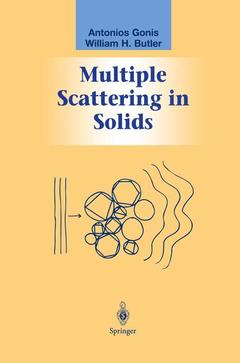Multiple Scattering in Solids, 2000 Graduate Texts in Contemporary Physics Series
Langue : Anglais
Auteurs : Gonis Antonios, Butler William H.

The origins of multiple scattering theory (MST) can be traced back to Lord Rayleigh's publication of a paper treating the electrical resistivity of an ar ray of spheres, which appeared more than a century ago. At its most basic, MST provides a technique for solving a linear partial differential equa tion defined over a region of space by dividing space into nonoverlapping subregions, solving the differential equation for each of these subregions separately and then assembling these partial solutions into a global phys ical solution that is smooth and continuous over the entire region. This approach has given rise to a large and growing list of applications both in classical and quantum physics. Presently, the method is being applied to the study of membranes and colloids, to acoustics, to electromagnetics, and to the solution of the quantum-mechanical wave equation. It is with this latter application, in particular, with the solution of the SchrOdinger and the Dirac equations, that this book is primarily concerned. We will also demonstrate that it provides a convenient technique for solving the Poisson equation in solid materials. These differential equations are important in modern calculations of the electronic structure of solids. The application of MST to calculate the electronic structure of solid ma terials, which originated with Korringa's famous paper of 1947, provided an efficient technique for solving the one-electron Schrodinger equation.
1 Introduction.- 1.1 Basic Characteristics of MST.- 1.2 Electronic Structure Calculations.- 1.3 The Aim of This Book.- References.- 2 Intuitive Approach to MST.- 2.1 Huygens’ Principle and MST.- 2.2 Time-Independent Green Functions.- References.- 3 Single-Potential Scattering.- 3.1 Partial-Wave Analysis of Single Potential Scattering.- 3.2 General Considerations.- 3.3 Spherically Symmetric Potentials.- 3.4 Nonspherical Potentials.- 3.5 Wave Function in the Moon Region.- 3.6 Effect of the Potential in the Moon Region.- 3.7 Convergence of Basis Function Expansions (*).- References.- 4 Formal Development of MST.- 4.1 Scattering Theory for a Single Potential.- 4.2 Two-Potential Scattering.- 4.3 The Equations of Multiple Scattering Theory.- 4.4 Representations.- 4.5 Muffin-Tin Potentials.- References.- 5 MST for Muffin-Tin Potentials.- 5.1 Multiple Scattering Series.- 5.2 The Green Function in MST.- 5.3 Impurities in MST.- 5.4 Coherent Potential Approximation.- 5.5 Screened MST.- 5.6 Alternative Derivation of MST.- 5.7 Korringa’s Derivation.- 5.8 Relation to Muffin-Tin Orbital Theory.- 5.9 MST for E < 0.- 5.10 The Convergence Properties of MST (*).- References.- 6 MST for Space-Filling Cells.- 6.1 Historical Development of Full-Cell MST.- 6.2 Derivations of MST for Space-Filling Cells.- 6.3 Full-Cell MST.- 6.4 The Green Function and Bloch Function.- 6.5 Variational Formalisms.- 6.6 Second Variational Derivation (*).- 6.7 Construction of the Wave Function.- 6.8 The Closure of Internal Sums (*).- 6.9 Numerical Results.- 6.10 Square Versus Rectangular Matrices (*).- References.- 7 Augmented MST(*).- 7.1 General Comments.- 7.2 MST with a Truncated Basis Set: MT Potentials.- 7.3 General Potentials.- 7.4 Green Functions and the Lloyd Formula.- 7.5 Numerical Study of TwoMuffin-Tin Potentials.- 7.6 Convergence of Electronic Structure Calculations.- References.- 8 Relativistic Formalism.- 8.1 General Comments.- 8.2 Generalized Partial Waves.- 8.3 Generalized Structure Constants.- 8.4 Free-Particle Solutions.- 8.5 Relativistic Single-Site Scattering Theory.- 8.6 Relativistic Multiple Scattering Theory.- References.- 9 The Poisson Equation.- 9.1 General Comments.- 9.2 Multipole Moments.- 9.3 Comparison with the Schrödinger Equation.- 9.4 Convex Polyhedral Cells.- 9.5 Numerical Results for Convex Cells.- 9.6 Concave Cells.- 9.7 Direct Analogy with MST.- References.- A Time-Dependent Green Functions.- B Time-Independent Green Functions.- C Spherical Functions.- C.1 The Spherical Harmonics.- C.2 The Bessel, Neumann, and Hankel Functions.- C.3 Solutions of the Helmholtz Equation.- References.- D Displacements of Spherical Functions References D.- References.- E The Two-Dimensional Square Cell.- E.1 Numerical Results (*).- References.- F Formal Scattering Theory.- F.1 General Comments.- F.2 Initial Conditions and the Møller Operators.- F.3 The Møller Wave Operators.- F.4 The Lippmann—Schwinger Equation.- References.- G Irregular Solutions to the Schrödinger Equation.- H Displacement of Irregular Solutions.- K Conversion of Volume Integrals.- L Energy Derivatives.- M Convergence of the Secular Matrix.- N Summary of MST.- N.1 General Framework.- N.2 Single Potential.- N.3 Multiple Scattering Theory.
Date de parution : 09-2012
Ouvrage de 285 p.
15.5x23.5 cm
Disponible chez l'éditeur (délai d'approvisionnement : 15 jours).
Prix indicatif 52,74 €
Ajouter au panier
© 2024 LAVOISIER S.A.S.



